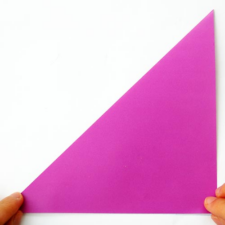Today, we are going to explore how to measure really tall things (like trees or lampposts) without needing a ridiculously long ruler. Remember, these measurements are estimations, so they are not perfectly accurate, but they will give you a good idea about how tall something is.
Measuring with a triangle
Take a piece of paper and fold it so it forms a triangle. You will want to use a corner of the paper as one of the corners of your triangle because this corner is 90°.

Take your triangle and hold it in front of your eyes like Mark does. You want to position the triangle so you are looking up the longest side, and the 90° angle is on the bottom of the triangle. As you are looking up the longest side of your triangle, step backwards or forwards so that the top of the tall object you are measuring just peeks out over the top of the triangle. You may want to close one eye for this part.
Once you have positioned yourself, measure the distance from where you are standing to the base of the tall object you are measuring. Then add your height to this number, and voila! You have an estimated height!
Measuring with Shadows
This measurement uses ratios to estimate the height of something tall. The idea is that at the same time of day, objects will cast shadows that are proportional to one another. If you know your height and the length of your shadow, you can use the length of a tall object’s shadow to estimate its height.
You’ll need to measure the length of your shadow and the length of the shadow of the tall object you want to measure. Make sure to take these measurements at the same time of day! Then you just need to do a little math.
The ratio we will solve to figure out the height looks like this:
Your Shadow/Your Height = Object Shadow/Object Height
You should have numbers for 3 of these values: your shadow length, your height, and the object’s shadow length. Solve for the object’s height by following these steps:
- Multiply the object’s shadow length by your height.
- Divide that answer by your shadow length.
- Congrats! You have an approximation for the height of your object.
These are two methods for approximating the height of a tall object. One uses geometry, while the other uses ratios. There are so many uses for mathematics in our lives, geometry is used in medicine, architecture, technology, and sports. When you wrap presents or fill a container without overflowing it – you are using geometry. You use ratios every time you double a recipe, or compare prices while grocery shopping, or estimate how long a trip will take. So go outside, measure some tall objects, and enjoy the math around you!
When you’re all done, we would love to see your results! Share your pictures and videos with us using #ScienceAtPlay.

Aoife Ryle is a STEM Educator at the Connecticut Science Center. In addition to working with school groups, she works with our Teen Program, Overnights department, and shoots weekly science segments for WFSB. She has a degree in Bioengineering from the University of Maine and has a personal interest in the life sciences and engineering which makes bioengineering a perfect crossover.

Mark Dixon is a meteorologist on WFSB Channel 3 Eyewitness News and a host of the weekly Science Sunday segments with the Connecticut Science Center. He has been nominated for several Emmy awards for weather anchoring and has won awards from the Connecticut Associated Press Broadcaster’s Association and the American Meteorological society.


